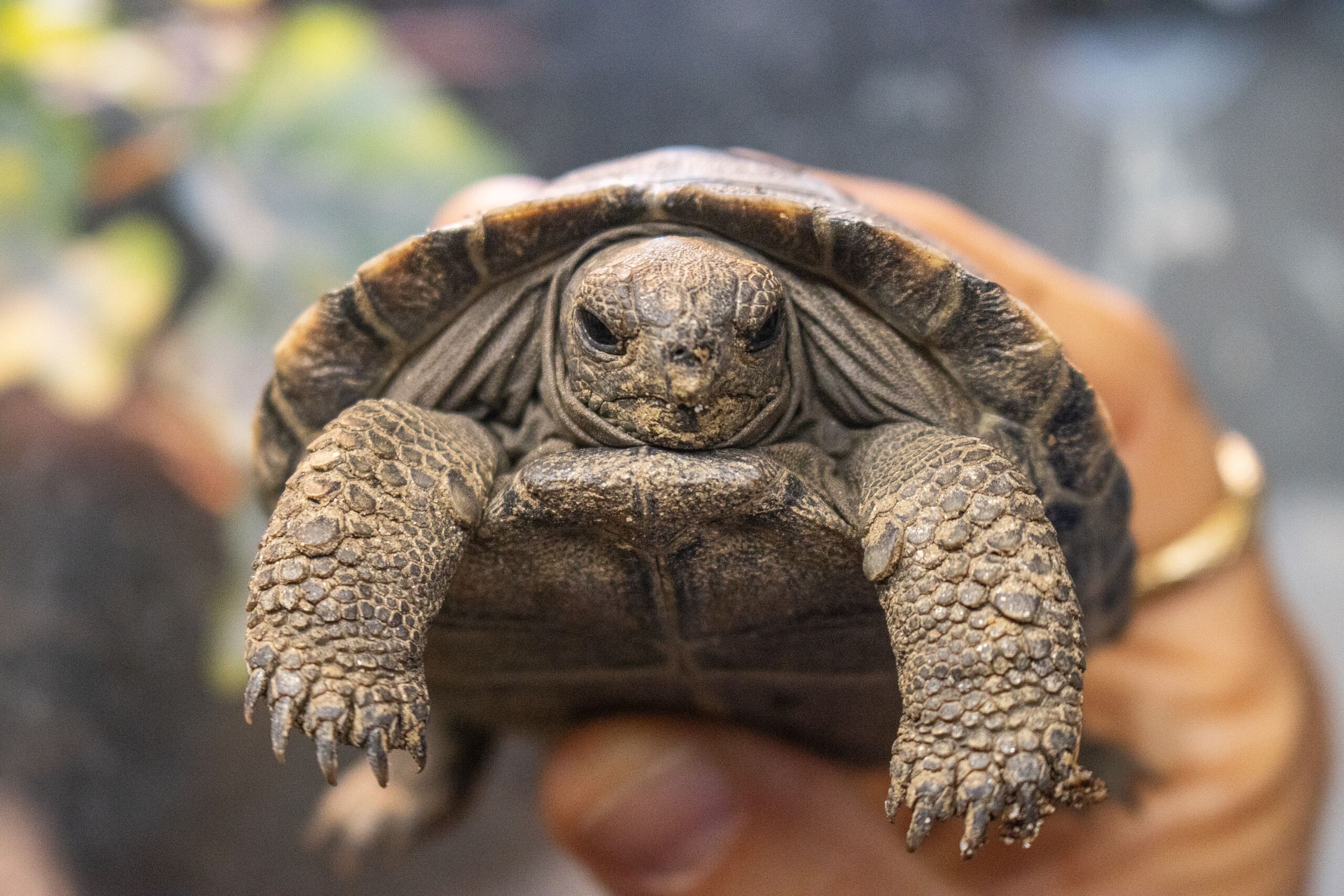Three More Critically Endangered Galapagos Tortoises Hatch at Philadelphia Zoo
Philadelphia Zoo is excited to share that three more critically endangered Western Santa Cruz Galapagos tortoises have hatched at the Zoo.
These hatchlings are from the same clutch of eggs that produced four female tortoises earlier in 2025. The hatchlings’ parents, female Mommy and male Abrazzo, are the Zoo’s two oldest residents, each estimated to be around 100 years old. Additionally, Mommy is considered one of the most genetically valuable Galapagos tortoises in the Association of Zoos and Aquariums (AZA) Species Survival Plan (SSP). She is also the oldest first-time mom of her species. The male hatchlings, currently behind-the-scenes inside the Reptile and Amphibian House, are eating and growing appropriately. The first male egg pipped (began hatching) on April 14 with the two others hatching in the following weeks. The male hatchlings do not have names at this time. The Zoo recently asked the public to weigh in and help choose names for the four female hatchlings, who are now named for the Golden Girls: Dorothy, Rose, Blanche and Sophia. In order to provide all the hatchlings with the best care possible, both the females and males will be spending time in their public habitat and their habitat behind-the-scenes in the Reptile and Amphibian House.
Additionally, the Zoo is monitoring eggs Mommy laid in January 2025 inside the Reptile and Amphibian House. Out of the 16 laid, nine of them continue to show signs of development inside the Zoo’s incubators. Six of them are being incubated at temperatures that produce males, and three are being incubated at temperatures that produce females. This clutch of eggs has reached its potential hatch window and could start to show signs of pipping in the coming days and weeks.
The babies are part of the AZA SSP breeding program to ensure the survival of this species and maintain a genetically diverse population. Western Santa Cruz Galapagos tortoises are listed as critically endangered by the International Union for Conservation of Nature (IUCN) with threats including human-wildlife conflict, the introduction of invasive species, and habitat loss.
The hatchlings, incubated as males, are the remaining eggs from the same clutch of eggs in 2024 that produced four females earlier this year.
“It is a joy to be able to share this next chapter with all those in our region, country and around the world that have been captivated by this story,” said President & CEO Dr. Jo-Elle Mogerman. “Mommy, Abrazzo, and the hatchlings are educating millions of people about their species and conservation. Those folks have become a part of this story. We encourage them to get involved by visiting the babies or by supporting their care however they can.”
“It is such a delight to have the final eggs of Mommy’s first viable clutch hatch,” said Vice President of Animal Well-Being Rachel Metz. “This success has been a years-long process from bringing Abrazzo to the Zoo in 2020, to fundraising for nesting materials in 2021 and introducing Mommy and Abrazzo in 2022. Our sincerest gratitude for this success goes to the passionate and diligent work by experts in the AZA community and the entire Philadelphia Zoo team, including the countless keepers that kept Mommy healthy and thriving over the last 93 years.”
Mommy laid 16 eggs in November 2024. The day after she laid them, the reptile and amphibian team dug them up to incubate eight as male and eight as female. The sex of Galapagos tortoise hatchlings is determined by the incubation temperature. Temperatures below 82.4°F produce males and above 85.1°F produce females. Eggs hatch after four to eight months. From that clutch, four females and three males developed and hatched. The animal care team is using different colors of nontoxic nail polish to place small spots on different parts of their shells to differentiate the hatchlings. The females have spots towards their hind legs while the males have spots near their front legs.
In celebration of this conservation achievement, the Zoo designed t-shirts to support the hatchlings’ care. The three designs are based off of photos taken of the baby tortoises and Mommy. Slogans include “Never Too Late,” “Saving Species Since 1859,” and “Live Long and Grow a Thick Shell.” Part of the proceeds will go to the Zoo’s animal care fund. T-shirts can be purchased here.
The Galapagos tortoise hatchlings are part of an Association of Zoos and Aquariums (AZA) Species Survival Plan (SSP) breeding program to ensure the survival of this species and maintain a genetically diverse population.
Galapagos tortoises are found on the Galapagos Islands in the Pacific Ocean off the coast of Ecuador. They are the largest living species of tortoise; males can grow to be 500 pounds while females average around 250 pounds. They are cold-blooded animals and spend one to two hours basking in the sun before spending another eight to nine hours grazing and relaxing. Scientists estimate they can live between 100-200 years old. There are currently 13 living species that are native to seven of the islands.
Philadelphia Zoo is home to three adult Galapagos tortoises, male Abrazzo, females Mommy and Little Girl, and seven hatchlings (four female and three male). Guests can visit the hatchlings inside the Reptile and Amphibian House. The hatchlings will remain at the Zoo for at least five years. The Zoo will work with the AZA SSP to determine when and if the hatchlings will move to different facilities. The Zoo is also home to two giant Aldabra tortoises, Wilma and Betty.

Adopt a Galapagos Tortoise
By adopting a Philadelphia Zoo animal, you share your love for animals by helping ours receive the best possible care.